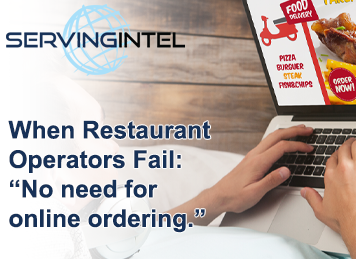
When Restaurant Operators Fail - "No need for online ordering"
Read time: 3 minutes
By: Lance Bell
The statistics are in, and online restaurant orders are skyrocketing!
According to Nation’s Restaurant News, 60 percent of U.S. consumers order delivery or takeout once a week. Restaurant Business Online claims 59 percent of restaurant orders from millennials are takeout or delivery. Statista cites 34 percent of consumers spend at least $50 per order when ordering food online.
There are several avenues in which a restaurant can begin receiving online orders.
First, you need a website. A complete site with fresh content is becoming more the norm today. While many providers can build and maintain a website for your restaurant, we believe that integration is an essential key to success. You should have a central data management system that allows you the ability to control your items, regardless if they are found for sale online or in your restaurant. All incoming online orders should print directly to your bar and kitchen, eliminating the need for any tablets and reentering ordering into your point of sale system.
Next, we recommend entering into agreements with all the third-party ordering systems which make sense for your business. The cost of these third-party systems ranges from 2.5% to as high as 32%. These third-party sites are mostly bringing new customers to your business, so the percentage is the cost to acquire a new customer. Many operators make a false relationship between this cost and their profit margin. We often hear, “How can I pay them 28% when my restaurant only generates 5% in profits?”
The profit question is answered by realizing that fixed costs are not a part of these additional revenue streams for your restaurant. Today, all of the brick & mortar (inside) sales cover the fixed costs, yielding the 5% profit. So a new $100 online order, minus food cost (35%), paper and supplies cost (5%), and the third party ordering system cost (20% average), leaves $40 in profit for that transaction. The only question to consider is– does your kitchen have the bandwidth to prepare the additional food sales? For most operators, the answer is yes.
Finally, it would be best if you could market to your customers, intending to move customers from third-party platforms over to your eCommerce website. We recommend a program with no maintenance required, where customers can sign themselves up via a website, and earn ‘store bucks’ redeemable on future purchases. Our partners typically set a reward threshold at 25% - 50% over the average check, so that rewards are received on about every other visit. 10 to 1 tends to be the best ratio for award earning.
So for example, a bar & grill with an average check of $35 might set their rewards level at $50, gifting loyalty members with $5 in-store bucks for every $50 spent. The cost of this marketing is the cost of goods sold for the store bucks granted. At 35% cost of goods sold, the restaurant is providing $1.75 in food cost for $50 in hard cash received, or 3.5%.
Our team created a solution that handles all theses functions and needs. We provide it to partners as a toolset they can manage, and we offer all this marketing as a service, billed as a percentage of the additional revenue. Are you ready to get online and start increasing your bottom line?
Lance Bell is the President of ServingIntel Inc., the leading senior living technology company specializing in interaction management software. Visit our solutions platform at www.servingintel.com/senior-living.
